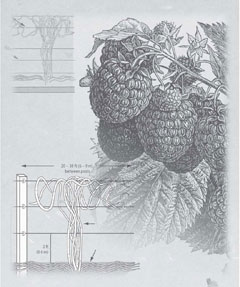
Growing Berries in Your Backyard
Growing Berries in Your Backyard | Blackberries | Raspberries | Strawberries | Blueberries
How should blackberries be trained and pruned?
Overview

Illustration from California Master Gardener Handbook
All blackberries require little to no pruning during the first year after planting. Thereafter, heavy annual pruning is needed. Trailing blackberries. During the first growing season, use the trellis to support the new canes growing from the plant crowns. Tie or wrap the canes around the wires. These canes will bloom and produce the first crop the following spring. In the spring, trailing blackberries produce vigorous shoots called primocanes that grow along the ground. Keep these trained on the ground beneath the bearing canes to prevent injury. At the same time, the two-year-old canes (floricanes), which grew the previous season and are trained on the trellis, will bloom and produce the first crop. Right after harvest, cut off all of the floricanes near the ground and remove them from the trellis, leaving 8 to 12 of the sturdiest primocanes on each plant to bear fruit the next spring. Wrap the primocanes around the trellis, from which all of the floricanes have been removed. Wrap one or two primocanes at a time in a spiral around the wires of the trellis, working each way from the plant. All other canes are cut back to the ground. Each year, primocanes should be cut back or headed to 8 to 10 feet long. Heading the canes forces lateral shoot growth that bears next year's crop. Erect Blackberries. Erect types produce stiff, upright new canes (primocanes) from the crown that arch over after they grow about 5 to 6 feet long. During the growing season, when the primocanes are approximately 3 feet tall, pinch off the top 1 to 2 inches. These canes will produce branches that will produce fruit the next year. Alternatively, the canes can be left unheaded and wrapped around the wires for fruiting next year. Immediately after harvest remove the floricanes. Thin the primocanes to three or four of the strongest canes per plant.
Associated Links
Publications
|
